Kangaroos, koalas, wombats, and Tasmanian devils belong to a special group of mammals called marsupials. Marsupials carry their young in pouches on their belly until they are big and strong enough to walk (or hop!) on their own. But you’re not likely to find a kangaroo hopping through the woods near your house, or a Tasmanian devil cleaning up roadkill along the interstate. That’s because they’re endemic, meaning that they are found in only one place on the planet. Their home, sweet home? Australia, the Land Down Under, mate! True, some marsupials do live in other places, like North America’s own Virginia Opossum, but two-thirds of all marsupials live only in Australia.
The views expressed in this article reflect those of the authors mentioned, and not necessarily those of New Creation.

This might sound confusing to a young-earth creationist. We know from Scripture that the global Flood decimated all air-breathing land animals except two of each kind aboard Noah’s Ark. The Ark landed in the mountains of Ararat, which most Bible scholars think is somewhere in modern Turkey. But if this is true why aren’t there any marsupial moles in the Sahara Desert? Why aren’t there sugar gliders in the Amazon Rainforest? How did two-thirds of all marsupials end up in Australia?
Creation Research Can Help Us Develop a Model
Contrary to popular belief, young-earth creation scientists don’t only want to debunk unbiblical claims about Earth history. They also want to develop a well-rounded understanding of the history of the world God created, one that is biblically sound and explains more evidence than the conventional understanding. To do this, we can develop a scientific model.
This is why we need to understand why so many marsupials ended up in Australia and how they got there! The research needed to solve this mystery is quite young, but progress has been made. As of now, there exist two proposed models. But before we get to them there are some more things we need to know about marsupials.
How Many For Your Traveling Party?
It should be remembered that not every species of marsupial was required to migrate to Australia from the Ararat region. God told Noah to take at least two of each kind of air-breathing land animal aboard the Ark. After the Flood these animal kinds diversified into many different species.
This means that every species would not have needed to migrate to Australia. Some species likely came from one ancestral kind that had previously migrated to the Land Down Under sometime after the Flood through the means of diversification. For example, kangaroos, wallabies, wallaroos, tree kangaroos, and quokkas all probably descended from a common ancestor that survived the Flood.1
Which Fossils Are From the Flood?

Some creationists attribute the bulk of the fossil record to the Flood. They commonly assume that any marsupial fossils we find are of those buried by this grand catastrophe. This is problematic, however, since the fossil counterparts of modern marsupials are also endemic to Australia. Are we to expect that these marsupials migrated from Australia to Ararat, and then only back to Australia?
Recent research from the field of Flood geology might be helpful here. In their research of the Earth’s rock formations, young-earth geologists have identified several criteria in the fossil-containing rocks they can use to differentiate those formed during the Flood and those formed after the Flood.2 For example, since the Flood was global, we would expect to find widespread marine deposits on the continents. Fossils of modern marsupial types, however, do not appear in these rock layers. We find them only in fossil sites on top of the Flood’s marine deposits, such as those formed in lakes, or those carved into Flood or early post-Flood rocks, like caves and sinkholes. This indicates that these fossils belonged to animals that lived after the Flood.
Marsupials did not travel from Australia, to Ararat, and then back to Australia. As they do not appear to be present in the Flood’s fossil record, we do not know where they were living before the Flood. (For all we know, they may have been living in the area where Noah built the Ark!) What we do know is that they were on the Ark, which landed in the mountains of Ararat. From there, they migrated to Australia for the first time after the Flood.
Why Isn’t There a Fossil Trail of Marsupials from Ararat to Australia?
Likelihood of Fossilization
Many people think that we should find fossils of marsupials between Ararat and Australia if such a migration occurred. But they forget that the fossil record is not a perfect snapshot of all life forms alive at any given point in time. This is because when an organism dies, it usually does not become fossilized. Most departed organisms are consumed by scavengers or simply decay to nothing in the elements. Therefore, the likelihood of any one individual becoming fossilized is quite slim.
It is for this reason that the fossil record is biased toward organisms with high population counts. If only a small number of a type of organism are in existence, it is unlikely that they will ever be found as fossils. As such, an organism’s fossil distribution may not reflect its total distribution throughout history. So the fact that we do not find Australian marsupials anywhere but Australia does not prove that this was the only place they lived. What it does suggest, however, is that the Land Down Under was the only place where they truly came into their own.
Filter-Bridges
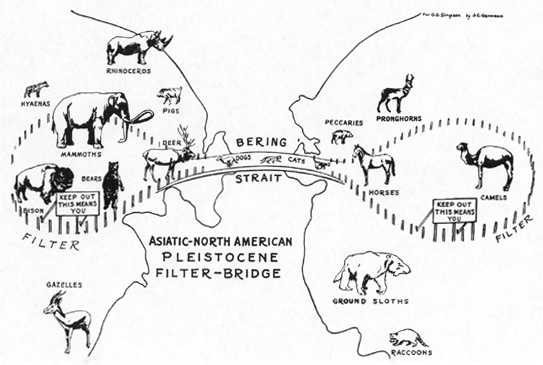
The migration route marsupials used to get to Australia may be an example of a filter-bridge. A filter-bridge is a natural barrier that prevents some animals from passing through while allowing others.3 It is possible that marsupials had certain features or abilities that allowed them to migrate to Australia. Perhaps there was something that prevented placental mammals (those that don’t carry their young in pouches) from making that same journey.
Or, maybe, Australia’s isolation made it possible for marsupials to gain a foothold there, unlike other places. One important factor to marsupial domination appears to be isolation from most other mammals. Many do not appear capable of living alongside placental mammals. Some scientists think that competition with dogs played a role in the complete extinction of the thylacine (a meat-eating marsupial).4 They may also be responsible for the extinction of the Tasmanian devil on the Australian mainland.5 Even today, the introduction of placental mammals like foxes6 and rabbits7 have sadly put native marsupials at risk of extinction.
If most marsupials were unable to compete with placental mammals in regions outside of Australia, it is little wonder that they never attained a high enough population to warrant their appearance in the worldwide fossil record.
Two Models: Sundaland Route vs. Down Under Route
Creation researchers have developed two tentative models attempting to understand the modern distribution of marsupials. Let’s take a look at them.
Sundaland Route

The most popular model among young-earth creationists is what we will call the Sundaland Route.8 This model suggests that the ancestors of modern Australian marsupials migrated through southeast Asia until they came to the Sundaland region. This region connected many Southeast Asian islands to the mainland during the Ice Age, when sea levels were much lower. From there, they traveled on to Australia.
This model has the advantage of being the most straightforward explanation. The main unresolved issue with it, however, is that the land connection was incomplete. Wallacea, a series of islands and deep water channels, separates Sundaland and Australia. To everyone’s knowledge, these channels have never been above sea level. One possibility is that marsupials utilized natural rafts to get across the wide stretches of ocean. In recent times, researchers have observed that animals have spread to new places across seaways by these same means.9 The natural rafts used in these instances typically consist of floating log mats, plant debris, and other vegetation.10
Down Under Route

Proposed by Chad Arment in 2020,11 this model can be called the Down Under Route. It suggests that the marsupials utilized natural rafts across the Atlantic, made their way down through South America, “down under” through Antarctica, and finally up into Australia. Evidence that backs up this model suggests that animals could (and in fact did) move between the aforementioned continents. Fossils of the extinct, flightless terror birds are mostly known from South America. The same is true of the modern-day, weak-flying hoatzins. However, the fossil records of both birds show up in Africa and Europe as well.12,13 Though only known in Australia today, fossil platypus teeth have been found in South America,14 and the fossils of one type of marsupial, Chulpasia, are known from both continents.15
Arment points out that according to the Upper Mesozoic/Lower Cenozoic Flood model advocated by most young-earth paleontologists, Australia and South America did not completely split from Antarctica until sometime after the Flood. This would have allowed animals passage across these landmasses. In addition, the Atlantic Ocean would have been narrower, reducing the amount of time animals would have to spend adrift on a natural raft.
Conclusion

Young-earth creationists have developed two models that attempt to explain how almost all marsupials ended up in Australia. By combining the research efforts from three different fields (geology, paleontology, and biology) we can attempt to answer tough questions like these. There is still more work to do, but progress is always an encouraging sign that we are moving in the right direction.
Footnotes
- Lightner, J. 2013. “Mammalian Ark Kinds.” Answers Research Journal, 5 (2012): 151–204. ↩︎
- Whitmore, J.H., and P.A. Garner. 2008. “Using suites of criteria to recognize pre-Flood, Flood, and post-Flood strata in the rock record with application to Wyoming (USA).” In A.A. Snelling (editor), Proceedings of the Sixth International Conference on Creationism, pp. 425-448. Pittsburgh, Pennsylvania: Creation Science Fellowship; Dallas, Texas: Institute for Creation Research. ↩︎
- Simpson, George Gaylord. 1940. “Mammals and Land Bridges.” Journal of the Washington Academy of Sciences 30, no. 4 (April 18): 137–163. ↩︎
- Boyce, James. 2006. “Canine Revolution: The Social and Environmental Impact of the Introduction of the Dog to Tasmania.” Environmental History. 11 (1): 102–129. ↩︎
- Johnson, C. N.; Wroe, S. 2016. “Causes of extinction of vertebrates during the Holocene of mainland Australia: arrival of the dingo, or human impact?.” The Holocene. 13 (6): 941–948. ↩︎
- “Threat Abatement Plan for Predation by the Red Fox (Vulpes vulpes)” (PDF). SW National Parks and Wildlife Service. 2001. Retrieved 29 April, 2022. ↩︎
- Cooke, Brain D. (2012). “Rabbits: manageable environmental pests or participants in new Australian ecosystems?”. Wildlife Research. 39 (4): 280. ↩︎
- Lacey, T. 2022. “Why Are Australian Animals So Unique, and How Did They Get There?” Answers in Genesis. Accessed 23 March 2022. ↩︎
- Censky, E., Hodge, K. & Dudley, J. 1998. “Over-water dispersal of lizards due to hurricanes.” Nature 395, 556. ↩︎
- Wise, K., Croxton, M. 2003. “Rafting: A Post-Flood Biogeographic Dispersal Mechanism,” Proceedings of the International Conference on Creationism: Vol. 5 , Article 37. ↩︎
- Arment, C. 2020. “To the Ark, and Back Again? Using the Marsupial Fossil Record to Investigate the Post-Flood Boundary.” Answers Research Journal, 13, 1–22. ↩︎
- Angst, Delphine, Eric Buffetaut, Christophe Lécuyer, and Romain Amiot. 2013. “‘Terror Birds’ (Phorusrhacidae) from the Eocene of Europe Imply Trans-Tethys Dispersal.” PLoS ONE 8, no. 11 (November 27): e80357. ↩︎
- Mayr, Gerald, and Vanesa L. de Pietri. 2014. “Earliest and First Northern Hemispheric Hoatzin Fossils Substantiate Old World Origin of a ‘Neotropic Endemic’.” Naturwissenschaften 101, no. 2 (February): 143–148. ↩︎
- Pascual, Rosendo, Michael Archer, Edgardo Ortiz Jaureguizar, José L. Prado, Henk Godthelp, and Suzanne J. Hand. 1992. “First Discovery of Monotremes in South America.” Nature 356, no. 6371 (April 23): 704–706. ↩︎
- Sigé, Bernard, Michael Archer, Jean-Yves Crochet, Henk Godthelp, Suzanne Hand, and Robin Beck. 2009. “Chulpasia and Thylacotinga, Late Paleocene-Earliest Eocene Trans-Antarctic Gondwanan Bunodont Marsupials: New Data from Australia.” Geobios 42, no. 6 (November–December): 813–823. ↩︎

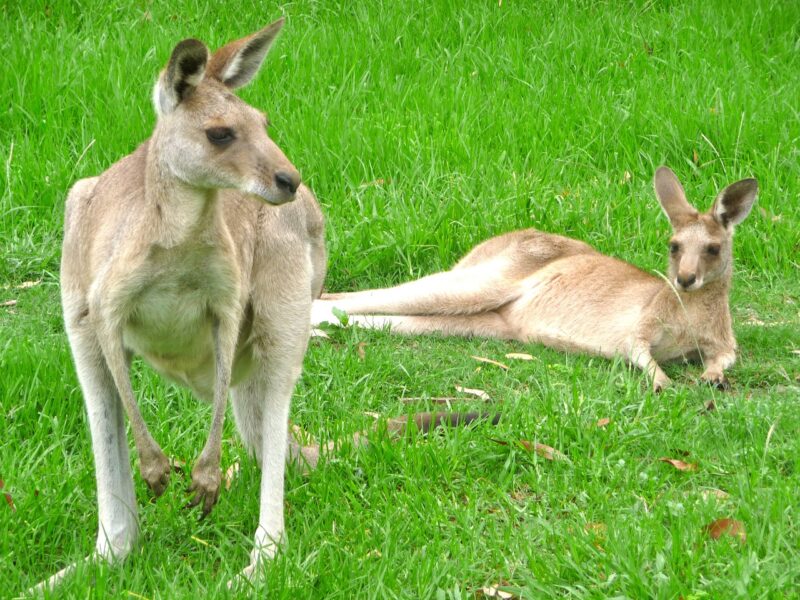


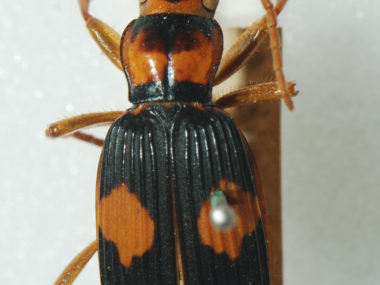
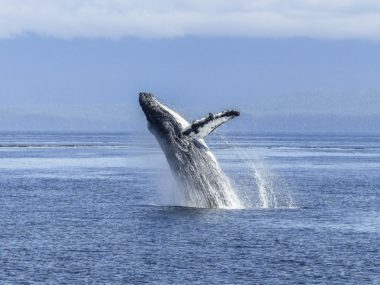
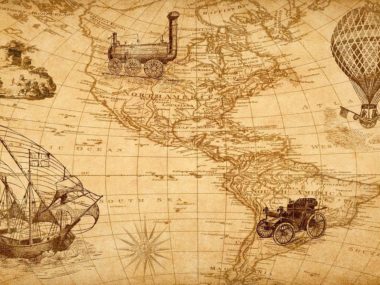
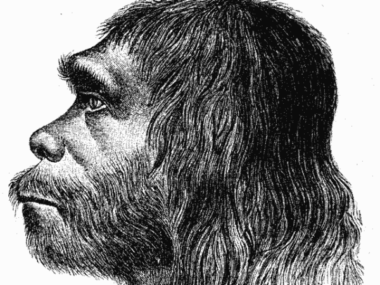




Glad to see this article. I have thought and studied about marsupials relation to biogeography for a long time. The answer is easy.
Marsupials are the same creatures as elsewhere and after the flood they simply in certain areas changed bodyplans to allow faster reproduction.
Its impossible for the marsupials to have gone THAT WAY but not other ways and other creatures NOT GO THAT WAY but everywhere else. IMPOSSIBLE> thats why opponents or thoughtful people ask how could creatures have migrated from the ark in such wonderful order of types.
A big thing in marsupials is they have exactly the same bodyplans as placentals. the marsupial; wolf, mole, lion, etc. tHis is. impossible from a creationist view. it simply is a minor tweeting after they migrated to Australia and South america.
It simply is they are the same creatures and later the water rose somewhat not allowing more creatures to come in.
If interested i wrote a Essay called “Post Flood Marsupial Migration Explained” by Robert Byers. just google.
I MAY BE in the left field here, BUT have y’all ever thought, looked at the theory that all land mass was connected like the “Gondola theory” BEFORE the flood, and AFTER the flood, the continental plates moved to where they are today??
Hello Andre,
Most creation scientists would put the division of the pre-Flood supercontinent during the Flood. However, there are a few who associate it with the division of the earth recorded as having occurred in the days of Peleg (Genesis 10:25). You can check out this article to read about one young-earth geologist who holds this view. If he is correct, then it is possible that this could help explain the distribution of marsupials and other animals after the Flood.
That is the most obvious, simplest explanation I have heard, and it makes a lot of sense to me. I don’t believe the dating of the breakup is “settled science”, so why not?
The amazing thing that always gets me is that people can believe that Moses made it through crocodile infested waters in a tiny basket, but they cannot believe God for things. He is God, after all. We should never have to get involved with having to explain things to people, but rather we should live by faith. Also, if you had done your Bible studies a little better, you would have read that 7 of every clean animal was put onto the ark and 2 of every unclean. I cannot in a moment decide whether Marsupials are clean, but I don’t eat possum. Doesn’t mean others can’t because they do. I have eaten squirrel and alligator and pork. I am a Protestant, except when it comes to most foods. I never protest food. : )
I think the key is diet. Changing Eucalyptus distribution over time probably was the chief influence. Outside of Australia marsupials had to adept but not very successfully, only a couple varieties. So why are Eucalyptus so prevalent down-under. The other factors mentioned in the article were certainly in play.
Good point! I had not thought of that, but food availability is a huge factor in all migrations.
1st out of the starting gate, we need to realize with God all things are possible with in the boundaries of Truth… Is evolution possible from a millions or billions of years perspective within God’s narrative, the answer is no… In 6 days God has said he created all things and on the 7th he rested… We still have that 7 day time clock today and it works very well… Common sense would argue, it’s an absolute far fetched notion that all of the intricate life we see formed randomly, by chance, and then in a following statement argue, it’s impossible, not a chance for animals to have migrated to other continents… It’s almost laughable to suggest, life came from nothing and evolved to everything, and then struggle with the concept how did animals migrate, and say it’s impossible to get to another current continent… Possibly it’s as simple as humans took them there via boats, rafts, after all, Noah and his family were already boat builders, were they not… Animals quite likely weren’t as wild in the early post flood era and made it much easier to manage and carry them off to distant lands…And of coarse the lands weren’t as distant at first… I fully believe people migrated to other continents much earlier after the Noah flood era, especially after the tower of Babel which was a significant time of global dispersion… Native Indians in America often criticize European settlers coming and taking over their lands, when they themselves were settlers from the eastern continent earlier on but they too were settlers from an earlier migration… That is a lot more plausible then to imagine everything came from nothing, only an empty mind can except that and then randomly create a narrative to fit the idea… Human minds are extremely open to deception, as we’ve witnessed not just in the last few years, where it’s normal for some to rationalize hundreds of genders, when biologically there has only been 2 genders for the past thousands of year, in the animal population as well in the human population… Simply desiring to believe something in the construct of reasoning doesn’t make something a reality or true…Just because humans can’t explain something doesn’t mean it’s not possible or true… This I do know, evolution in the sense as explained by the modern evolutionists is beyond belief, massive leap of faith I don’t buy… The fact that all things created, have a creator, is logical and factual… It’s naive to say, well it just happened by chance… Truth is grounded in existence, understanding meaning and value…
Very interesting. It is possible their were land bridges and they disapeared because of the ring of fire. the extensive volcanic activity in these areas destroys and forms land mass all through time. also possible people took animals with them when they migrated.
not so sure this explains how most of the marsupials ended up in australia or why migrants decided to take them, but perhaps this was what God wanted so it happened.
I come up with a big question when reading this article. You make mention that marsupials didn’t migrate to Ararat then back… but if that’s not true, then how did any and all the animals get to the Ark? Animals were all over the place, were they not, before the flood, so of course they had to travel (migrate) to get to the Ark and then travel (migrate) to whereever they wanted to go? Since the world land masses were different after the flood, they had the opportunity to go wherever God wanted and difected them?!?
Here’s my take on the majority of marsupials ending up in Australia. My reasoning assumes two things: 1) the Bible is a history of the earth that should be taken literally except where it cannot be so interpreted due to the text (Jesus’ statement, “I am the vine,” obviously cannot be taken literally), and 2) many animals have an instinct to migrate, and when displaced, they can have a “homing instinct” that urges them to go back to their original locations on the earth. (We all know of stories of pets travelling many miles to return to their original location after being dislocated by the humans with whom they were living.)
So, here goes:
1. God created the heavens and the earth.
2. On the third day, God gathered the waters on the earth into one place:
Gen. 1:9 – Then God said, “Let the waters below the heavens be gathered into one place, and let the dry land appear”; and it was so.
This would imply (by physical law) that there was also only one place on the earth where there was dry land.
Also on day three, God made all of the plants grow that would be necessary for food for the animals that were about to be created. It would be no problem for God to create the necessary plants in the locations necessary to feed the animals He would create in those locations.
Thus, there is no need for the assumption of “land bridges” between portions of land, since the land was all one mass at that time.
3. The flood happens. This also includes the event that God drew all of the animals He wanted to save to the location of the ark—a kind of “reverse migration.”
4. After the flood, the animals are either drawn back to their original locations by God, or they respond to migratory instincts, including “homing instincts,” and return to their original locations on the earth.
5. Many years later, the tower of Babel happens, and multiple languages are then created. In Genesis, this event must be recorded out of order (in chapter 11), since in chapter 10 we see the people divided by “languages,” which was not true of the people before the events of the tower of Babel. Gen. 11:1 says the people had one language.
6. During the lifetime of Peleg (recorded in Genesis 10:25), the earth was “divided.” This root word is not only the source of Peleg’s name, but is also used for many events in the Scriptures where there was a division (or “channeling”, or “dividing by water”):
Prov. 21:1 – The king’s heart is like channels of water in the hand of the Lord;
Ps. 65:9 – The stream of God is full of water;
Job 20:17 – “He does not look at the streams, The rivers flowing with honey and curds.
Job 29:6 – And the rock poured out for me streams of oil!
Ps. 1:3 – He will be like a tree firmly planted by streams of water,
Ps. 46:4 – There is a river whose streams make glad the city of God,
Ps. 119:136 – My eyes shed streams of water,
Prov. 5:16 – Streams of water in the streets?
Isaiah 30:25 – there will be streams running with water
Isaiah 32:2 – Like streams of water in a dry country,
Lam. 3:48 – My eyes run down with streams of water
Between the end of the flood and the lifetime of Peleg, the “Australian” marsupials could easily have migrated back to their original locations. Then, when the “canal” effect, or dividing by water happened (what we might call the “drifting of the continents,” (though it was probably much more of a cataclysm than a “drifting”), the animals would be isolated on different land masses.
This isolation of the land masses, with different animals and humans on each one, will also explain genetically many of the species that have resulted, and variations of homo sapiens (or races, if you will).
So, I don’t see much of a problem with how most of marsupials ended up in Australia. If that was their location on the one land mass, and then some were saved in the ark, and then they migrated back to their original location, only to be separated on the land mass of “Australia” when the “earth was canaled by water,” then does not need to go outside of the history presented in the Bible to understand this phenomenon.
One picky little detail: the word “decimate,” from a practice of the ancient Romans, means to kill every tenth one. The Flood did a lot worse than that. “Devastate” would be a better word.
First, let me say that I am a young-earth creationist. (My materials are available online at http://www.creationorevolution.net/creation-in-science-education/ .)
I have also thought that since marsupial babies travel in their mothers’ pouches, the species could travel faster than the placentals, in which the young have to walk. However, this does not explain monotremes, which are known only from Australia. (Fossils in the Cretaceous as well as living forms.) They do not travel in their mother’s pouch but must walk. Any thoughts on why living monotremes are found only in Australia?
Thank you Mr. Ryan for another fine article. I always enjoy reading them, discussing your ideas and sharing your knowledge. Keep up the good work!